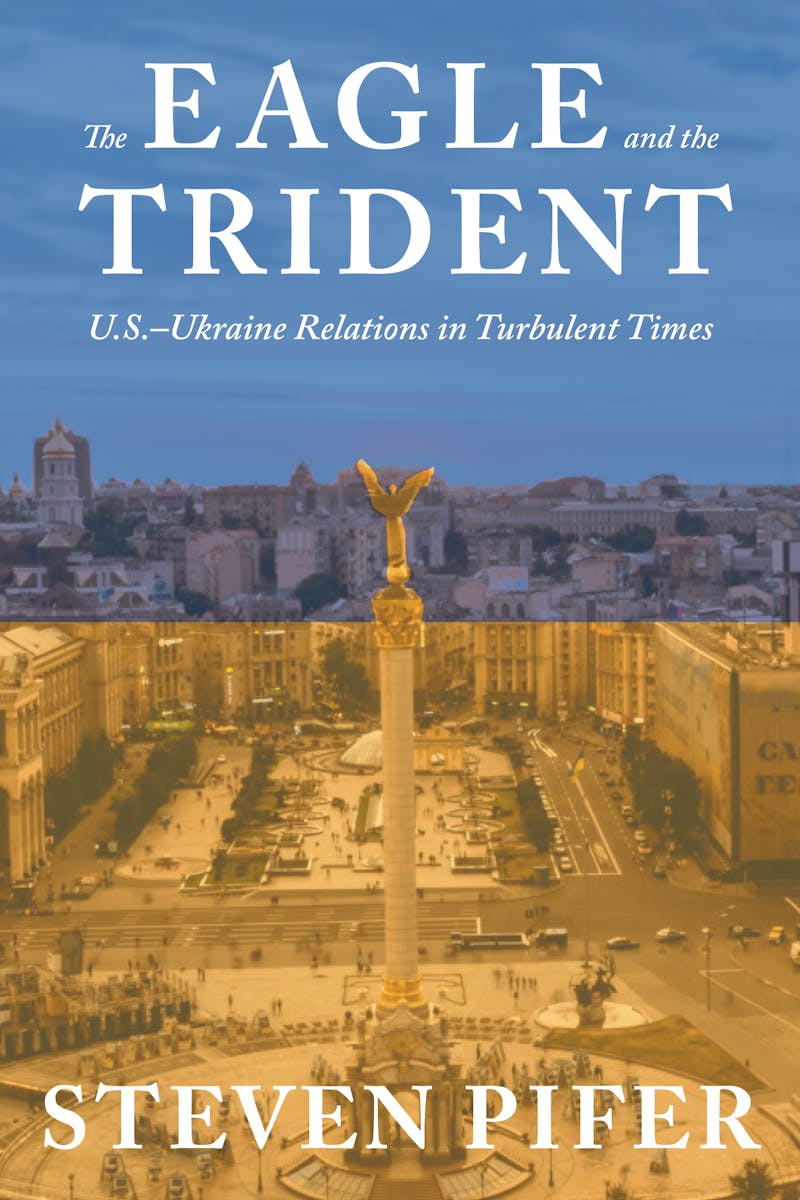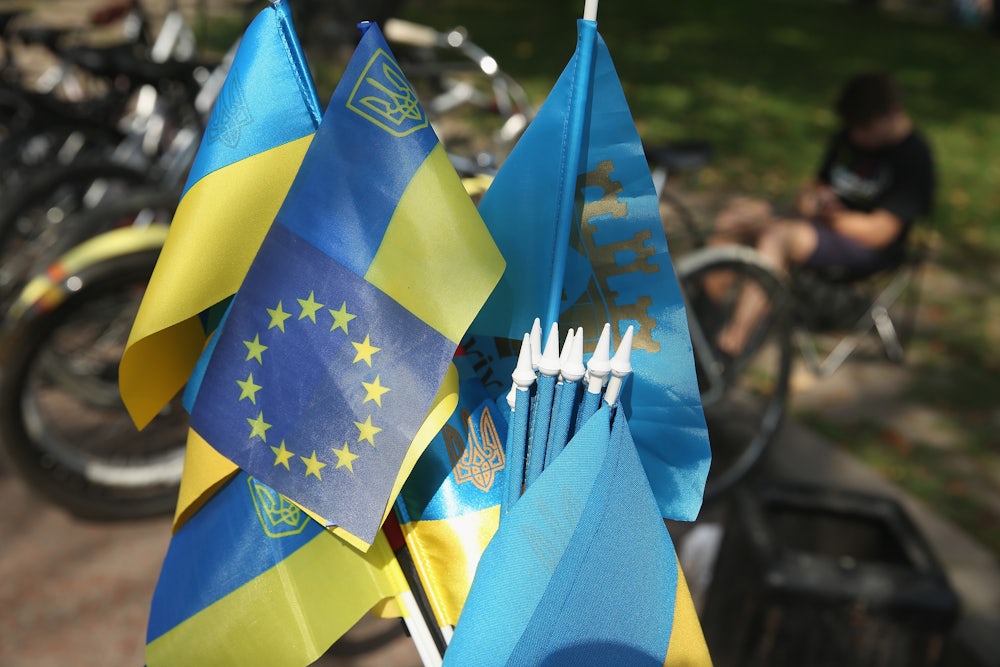In October 1994, Ukraine’s Foreign Minister, Borys Tarasyuk, came to Washington. There he met with Deputy Secretary of State, Strobe Talbott, with whom Tarasyuk raised the question of NATO enlargement. Tarasyuk noted Moscow’s growing discontent about NATO. In the event of enlargement, what was the American vision for Ukraine, Tarasyuk asked? Would Ukraine be consigned to a place in between, to the east of the West and to the west of Russia? A buffer zone? A gray area? Talbott acknowledged that he did not yet have a good answer. He was optimistic, however, about arriving at one over time.

This exchange appears in a new book by Steven Pifer, The Eagle and the Trident: U.S.-Ukraine Relations in Turbulent Times. Pifer was the U.S. Ambassador to Ukraine from 1998 to 2000. He has served at the National Security Council and the State Department and is now a fellow at the Brookings Institute. Before 2014, his excellent study of U.S.-Ukraine relations would have garnered mostly specialist interest. Given the severe and ongoing downturn in U.S.-Russian relations, the origins of which lie in Ukraine, The Eagle and the Trident deserves a wide readership. It contributes materially to our understanding of international affairs in the present tense.
Historically, Ukraine has tended to fall between the cracks of American foreign policy. Shortly after Soviet Union collapsed, Secretary of Defense Dick Cheney hoped that “an independent Ukraine … could serve as a check on Russian power,” Pifer recalls. At the same time, Secretary of State James Baker “strongly resisted new commitments to Ukraine.” In particular, he resisted anything resembling an American security guarantee. Cheney and Baker had arrived at mutually exclusive positions: For a militarily weak Ukraine to serve as a check on Russian power it would need expansive American backing. Cheney’s vision proved too hard-edged for the 1990s, when Presidents Bill Clinton and Boris Yeltsin were able to cooperate with one another.
During this period, the United States also placed too heavy an emphasis on nuclear disarmament, Pifer argues. Ukraine possessed the world’s “third largest nuclear arsenal” after the breakup of the Soviet Union. Its denuclearization was a precondition for normalcy as an independent post-Soviet state, for not going the way of Iran and North Korea. Yet, in Pifer’s view, Ukraine’s denuclearization was too narrow an American priority. It came at the expense of backing reform in a country that never had a 1989-style revolution. After 1989, Ukraine’s political fate would diverge dramatically from that of its more fortunate European neighbors—Poland, the Czech Republic, and Hungary. For the past 25 years, Ukraine’s stubborn poverty and “endemic corruption” have been crushing.
In the 1990s, Washington expected that all post-Soviet states would inevitably transition to democracy. The operative question—for Russia, for Ukraine—was when not whether they would make this transition. Though Cheney and Baker differed on the kind of security commitment to offer Ukraine, they both supported the project of “Westernizing” Ukraine. Pifer characterizes the core American objective in the following words: to see Ukraine “develop as a stable, independent, democratic state, with a growing market economy and increasing links to the West.” Washington wanted to “increase Ukraine’s links with the West,” to assist in “anchoring Ukraine to the West,” to guide Ukraine in its “westward course,” to see “its integration into the Euro-Atlantic community,” to assist in its “European aspirations,” and to honor the “importance of Ukraine drawing closer to Europe.”
According to Pifer, President Clinton’s 2000 visit to Ukraine was intended to “affirm Kyiv’s links with the West.” A year later, in a speech in Warsaw, President Bush made the same point: “Some in Kyiv speak of their country’s European destiny,” he proclaimed. “If this is their aspiration, we should reward it.” Less European destinies were presumably less deserving of reward.
Pifer can still envision a Ukraine “close to ready for EU membership.” Hence, he can still envision an EU willing to incorporate Ukraine. Considering the current state of affairs—continuing military conflict in Ukraine’s East, strenuous Russian opposition to the further expansion of NATO and the EU, a U.S.-Russian relationship on the edge—EU membership for Ukraine is unlikely. Pifer’s is a conclusion rooted in the post-1991 American vision for Ukraine, which was too vague to answer Foreign Minister Tarasyuk’s question. What was the American vision for Ukraine? And, by extension, what should it be today?
The American vision of a Ukraine anchored in the West comes up against three separate problems. First: This vision can confuse the goal of reform, of creating a well-functioning state, with the geopolitical program of fashioning Ukraine into a bulwark against Russia. Second, it has the potential to be rhetorically grand and institutionally or practically meaningless, if Ukraine’s integration into “the Euro-Atlantic community” does not equal membership in NATO and the European Union. And third, it has the potential to exacerbate internal tensions in Ukraine, which has suffered from East-West divisions ever since 1991. Within Ukraine, a Western Ukraine can be shorthand for a Ukraine dominated by its more nationalistic, more Ukrainian-speaking, more European-leaning Western half.
Washington never took serious steps to build a fortress Ukraine on Russia’s border, but its dream of a Western Ukraine made non-alignment unattractive in American eyes. Ukraine’s first president, Leonid Kravchuk, had an affinity for the West, and “U.S. officials quietly hoped for Kravchuk’s reelection” in 1994. Kravchuk lost this election to Leonid Kuchma, whose orientation was not as Western, although he aspired toward Ukraine’s eventual membership in the EU. Kuchma articulated a “multi-vector” foreign policy for Ukraine, by which he meant a triangle of decent relations with Russia, Europe and the United States. In 1995, his administration flirted with the idea of adopting “permanent neutral status with guarantees,” analogous to the neutrality devised for non-NATO Austria in 1955. Washington showed little enthusiasm for the idea.
East-West difficulties persisted in Ukrainian politics. Kuchma’s authoritarian tendencies, combined with his interest in deepening economic ties with Russia, sparked protests in several Western Ukrainian cities in 2003. When it seemed that power might slip illegally from the not-very-Western Kuchma to Victor Yanukovich, whose base of support and whose ideological inclinations were openly Eastern, Ukrainians mounted the Orange Revolution of 2004. Viktor Yushchenko became president in 2005. He was a Westernizer or a reformer—interchangeable terms in Pifer’s lexicon, as they are for most American experts and policy makers. Yushchenko wanted “integration with institutions such as NATO and the European Union,” and U.S. officials “largely shared Yushchenko’s vision for Ukraine,” Pifer writes, although the United States was in no rush to usher Ukraine into NATO.
By contrast, Yanukovich favored official status for the Russian language, a circumscribed relationship to NATO and greater proximity to Russia. His party did so well in the 2006 parliamentary elections that he would become Prime Minister in 2006, at which point only 20 percent of Ukrainians supported joining NATO. Employing dirty tricks, Yanukovich would go on to become president in 2010.
Yanukovich’s victories, such as they were, indicated an important truth about Ukraine. The country’s linguistic, ethnic and religious variety compelled it to vacillate—politically—between East and West. Rather than choosing between some prefabricated Western status or some prefabricated notion of Ukraine as merely an appendage of Russia, a post-Soviet Ukraine would have thrived by imitating Canada or Switzerland, economically and militarily strong countries that have found flexible ways of accommodating linguistic, ethnic and regional differences.
In 2000, the world changed around Ukraine. Vladimir Putin came to power, a man eager to assert Russian interests and, by modernizing the Russian military, to improve Russia’s capacity to assert its interests. In 2007, he gave a scathing speech at the Munich Security Conference, accusing the West of sponsoring a series of colored revolutions, a line of continuous perfidy running from Iraq in 2003 to Ukraine in 2004 and beyond. A collision course between Russia and the West was already visible. At a NATO summit in Bucharest in 2008, France and Germany opposed offering a membership action plan to Ukraine and Georgia. As compensation for their geopolitical thrift, a statement was released in Bucharest declaring that Georgia and Ukraine “will become members of NATO”—the promise of membership as apologia for the denial of a membership action plan. In 2008, on the eve of war with Georgia, Putin was not in an accommodating mood, and neither was NATO.
Pifer draws his narrative to a close in 2004. During the Maidan uprising of 2013 to 2014 he was no longer in government service. Therefore The Eagle and the Trident does not delve into the most recent events. It only sketches Yanukovich’s last-minute decision not to sign the association agreement with the EU (in November 2013), the outrageous corruption of his government and the ensuing revolt against him. Massive protests resulted in his flight to Russia in February 2014, which was followed in quick succession by Russia’s annexation of Crimea and invasion of the Donbas. Pifer leaves the chronicling and the explanation of these momentous events to other authors.
What The Eagle and the Trident explains is kind of intellectual vacuum, in the United States and in Europe, where Ukraine has been concerned. Without intending to, Pifer outlines a deficit of political imagination, which is a backdrop to the crises of 2014. Striving for a Western Ukraine made sense in the 1990s when the European borders between East and West were fluid. After 2000, it devolved into a mantra rather than a strategy, and as a mantra its essential power was the power to hide.
It hid the limits of Europe’s and America’s hard-power commitments to Ukraine, the recalcitrant fact that neither Brussels nor Washington (not to mention Paris or Berlin) actually believed that Ukraine “will become” a NATO member. It hid the discrepancy between Western norms of law and business and the actualities of Ukrainian political economy from 1991 to the present. (Ukraine stands at 131 on the 2016 Transparency International corruption index; the most corrupt of the EU member states, Greece, stands at 69; Germany stands at 10.) It hid the countless ties between Russia and Ukraine, uninteresting perhaps when Russia was drawing closer to the West but highly relevant whenever there is conflict between Russia and the West. Foreseeing such conflict in 1994, Borys Tarasyuk was rightly worried that Ukraine would get caught in the crossfire.
The crises of 2014 and beyond were not caused by a deficit of political imagination in Washington or in Europe. They were caused by Russia’s overreaction to political instability in Ukraine, instability that arose as much from accident and circumstance as it did from a grassroots desire to remake Ukrainian politics. But the United States and Europe have struggled to respond to Russia’s actions. The United States and Europe enacted a meaningful sanctions regime and these sanctions have helped to contain the war in Ukraine, but there is much in the troubled status quo that is unsustainable. A new vision will have to be formed. Or, put differently, Washington will finally have to choose between giving Ukraine a binding security guarantee and negotiating for its neutrality, between a Ukraine that serves as a check on Russian power and a Ukraine that will seek some sort of modus vivendi with Moscow. For those interested in the making of this choice, all of the necessary history is contained in The Eagle and the Trident.
